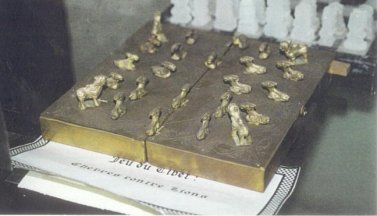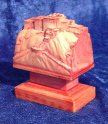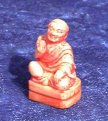Chandraki, Tibetan Chess
Chandraki is Tibetan Chess, Chess supposedly played in Tibet. Also reported under the following names : Chandaraki, Chadraki.
A set of Tibetan
Chess is owned by Roerich
Museum in Moscow. Here are some photographs which have been
kindly communicated to me by Lev Kisliouk. Both him and the
General Director of Roerich Museum are deeply acknowledged here
for their favor.
|
|
Remarks:
I have not seen this set personnally.
I don't know if those pieces come from a single set or several ones.
I think that both photographs of "Monks" are showing the same piece but I'm not sure. Maybe it is also the case for the two Castles.
At first sight, it seems that there are two colors, white and red. However, it could be the result of a different lighting as one Castle has both white and red.
Castles are probably Rooks and indicate an European influence.
Pawns also, are different from Mongolian ones which are usually childs or small animals.
I assume that the seated figures with pointed hat are the Kings. They are very similar to the Mongolian design.
In a personal communication, Lev Kisliouk made a very interesting hypothesis: he sees 7 types of piece in this set and that the man sitting on a stood could be a Bodyguard like in Hiashatar.
I don't know what are the deities and the monks. They could be playing the roles of Queens and/or Bishops, like Ministers or Counsellors. If such case, they would be completely different from Mongolian counterparts.
Please contact me if you have any opinion or information.
DISCUSSION
The word "Chandraki" denotes a possible connection with Sanskrit "Chaturanga", then indicating a probable Indian origin. This is not surprising as this mountain kingdom has been very influenced by Indian culture. Buddhism penetrated Tibet at the beginning of the 7th century at the time when king Sron-btsan sgam-po (610-649) unified the country. Tibet also took its writing system from the Sanskrit alphabet.
Tibet also had a strong influence, at his turn, on Mongolia. It was occupied by the Mongolian general Uriangqatai (1257-1258) and it cames that a young lama, Phags-pa from the famous Sa-skya-pa school got the favors of Khubilaï (1260-1294), Mongolian emperor of China. From then, the Tibetan monks never stopped their efforts and were finally successful when Mongolia got converted to Buddhism in 1576 with the nomination of a Dalaï-lama.
The proposed
names of the pieces and their meanings are the following
(source:
H.J.R.Murray, "A history of Chess", Oxford,
1913.):
|
Name |
meaning |
equivalent |
|
Dpon, Seng-ge |
Lion |
Prince |
|
Stag |
Tiger |
Queen |
|
Rnge-mong |
Camel |
Bishop |
|
Rta |
Horse |
Knight |
|
Shing-rta |
Cart |
Rook |
|
Bu |
Child |
Pawn |
Therefore, similarities in the meaning of the pieces in both Shatar and Chandraki should not be surprising. However, there is no more connexion than that. As the matter of fact, there is no information available about the methods of play which could corroborate a lineage between both games.
One can even question if that thin description of Chandraki by Murray is really true ?
Pritchard, 1994 only quotes Murray, 1913. Murray indicated that his source was M. Padérin, Secretary to the Russian Consulate in Mongolia in 1874. Murrays says (p368) "He presumably obtained them [the names of pieces and moves] from some Buddhist pilgrim who had visited Tibet. It is possible that he merely translated the Mongol names into Tibetan". Murray cross-checked the name of pieces with dictionnaries although saying "none of them is given as used in chess".
However, according to Murray again, the Tibetan were playing a form of Chess similar to ours as it was reported by witnesses tripping in Tibet in 1775 and 1856.
So far, I have been unable to find any more information about this kind of Chess. I do think that all those who report a typical Chess from Tibet have simply read Murray a bit too fast (it is true that Murray's book has 900 p and there are other parts where people are mistaking with this unsurpassed work !).
On January 2004, an informant from Lhasa wrote me the following: "The Tibetans don't play Chess or Xiangqi. I am sure you knew that Qiangqi (sic) is being played in the Mainland China, not the Tibetans. The Chandraki you said is unknown according to our staff whom I've asked right now. They play the "GalPoGelTze", it's a Tibetan kind of Chess they're playing in here...there's also a King, horse on it, etc,... Sorry, I can't tell you the detailed rule of the game."
GalPoGelTze does not seem to be a Chess game. According to the same Tibetan informant, its board is plain with marked lines and its size may vary according to what the players draw. It uses 13 pieces per player: 1 King & 12 soldiers. It is for 2 players only. If not carved with wood, King & Soldier can simply be played with apricot seed or stones.
It seems to me that a similar war game is encountered in Cambodia under the name Rek.
There is another Tibetan game which is presented at the "Musée International du Jeu d'Echecs" of Scorbé-Clairvaux, close to Poitiers, France. However, it is not a Chess game, it would better be categorized as a Hunt game with unequal side, as it opposed 20 Goats to 4 Lions.

Lions
versus Goats, a Tibetan game (thanks to Roldolfo Pozzi for this
photograph)
Then, I do not know if an original Chess, cousin of Indian or Mongolian versions, exists or existed there. If you have any elements about Chess in Tibet, please contact me.




















